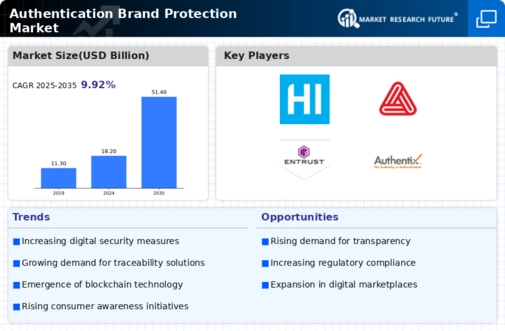Regulatory Compliance
Regulatory frameworks aimed at combating counterfeiting are becoming more stringent, thereby influencing the Global Authentication Brand Protection Market Industry. Governments worldwide are enacting laws that mandate brands to implement robust authentication measures to protect consumers. For instance, the European Union has introduced regulations that require enhanced traceability for certain products. Compliance with these regulations not only protects consumers but also enhances brand reputation. As a result, companies are increasingly investing in authentication solutions to meet these legal requirements, further propelling market growth.
Global E-commerce Growth
The rapid expansion of e-commerce platforms is a significant driver of the Global Authentication Brand Protection Market Industry. As online shopping continues to grow, so does the risk of counterfeit products infiltrating digital marketplaces. Brands are increasingly recognizing the need for robust authentication solutions to protect their online presence and maintain consumer trust. For instance, major e-commerce platforms are implementing stricter policies to combat counterfeit listings, prompting brands to invest in authentication technologies. This trend is expected to drive market growth, as companies seek to safeguard their brands in the evolving digital landscape.
Market Growth Projections
The Global Authentication Brand Protection Market Industry is projected to experience substantial growth over the next decade. With an anticipated market value of 18.2 USD Billion in 2024, the industry is expected to expand significantly, reaching 51.4 USD Billion by 2035. This growth trajectory indicates a robust demand for authentication solutions, driven by various factors such as rising counterfeit concerns and technological advancements. The projected CAGR of 9.92% from 2025 to 2035 further underscores the industry's potential for expansion, reflecting the increasing importance of brand protection in a globalized economy.
Technological Advancements
Technological innovations play a crucial role in shaping the Global Authentication Brand Protection Market Industry. The emergence of blockchain technology, artificial intelligence, and machine learning has enabled brands to implement more sophisticated authentication methods. These technologies enhance traceability and transparency, allowing consumers to verify product authenticity easily. For example, brands in the pharmaceutical sector are increasingly utilizing blockchain to ensure the integrity of their products. As these technologies continue to evolve, they are likely to drive market growth, with a projected CAGR of 9.92% from 2025 to 2035.
Rising Counterfeit Concerns
The increasing prevalence of counterfeit products across various sectors is a primary driver for the Global Authentication Brand Protection Market Industry. As consumers become more aware of the risks associated with counterfeit goods, brands are compelled to invest in authentication technologies. For instance, the luxury goods sector has seen a notable rise in counterfeit incidents, prompting brands to adopt advanced solutions. This trend is expected to contribute to the market's growth, with projections indicating a market value of 18.2 USD Billion in 2024, underscoring the urgency for effective brand protection measures.
Consumer Demand for Transparency
There is a growing consumer demand for transparency regarding product origins and authenticity, which significantly impacts the Global Authentication Brand Protection Market Industry. Consumers are increasingly seeking assurance that the products they purchase are genuine and ethically sourced. This trend is particularly evident in sectors such as food and cosmetics, where consumers are more discerning about product quality. Brands that prioritize transparency and authenticity are likely to gain a competitive edge, driving investments in authentication technologies. This shift in consumer behavior is expected to contribute to the market's expansion, with projections indicating a market value of 51.4 USD Billion by 2035.















